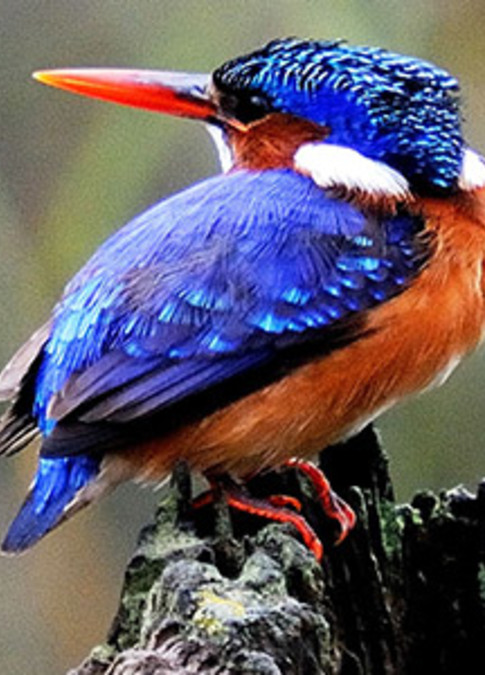Amazing Adaptations: South African Ostrich
Seeing birds and animals in their natural habit while on safari is a wonderful experience. It is even more interesting when you know about some of their amazing adaptions. You will understand their behaviours and appreciate your safari experience even more. We hope you enjoy this video and article about the amazing adaptations of the South African ostrich, often seen while on safari at Kariega Game Reserve in South Africa.
The flightless ostrich is the world’s largest bird. Ostriches also hold the record of being the largest and heaviest birds in the world, making flying impossible. They can weigh up to 150 kilograms (330 lbs) and can reach up to 2.7 meters (9 feet) tall.
South African Ostrich Feather Adaptations
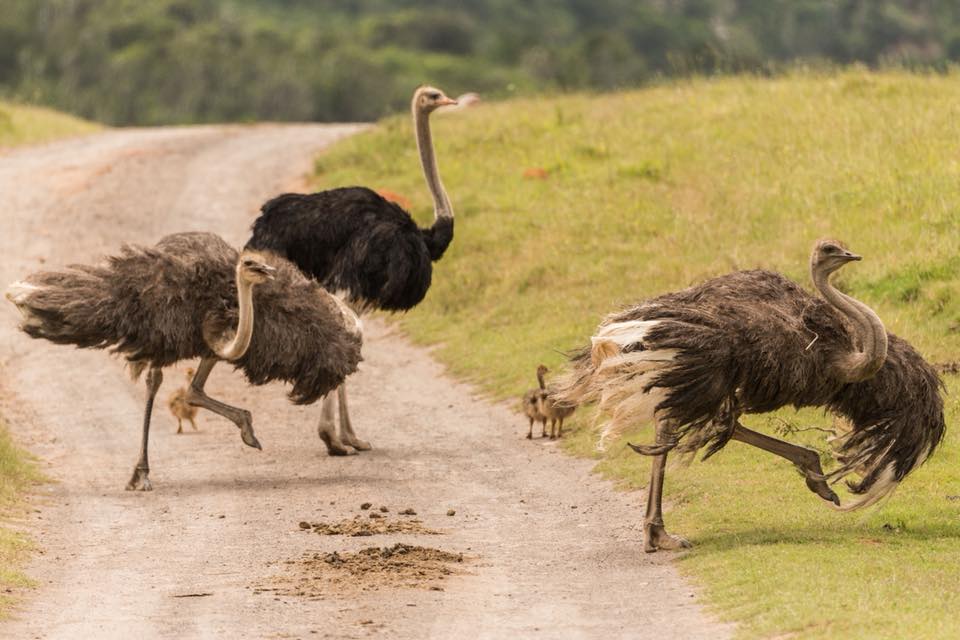
The video focusses on ostrich feathers and mentions some of their amazing adaptations. Adult male ostriches have black and white feathers while females and juveniles have grey-brown and white feathers.
As ostriches are unable to fly, their feathers are adapted to help them regulate their temperature. The structure of an ostrich feather is different to flying birds which have tiny hooks to lock them together during flight. The feathers of the South African or common ostrich can be used to help the birds cool down. To do this ostriches contract their muscles which raises their feathers from their bodies and increases the air space next to their skin. This cools the body temperature of the ostrich. When it is cold, ostriches flatten their feathers to improve their insulation and conserve body heat.
Ostrich males use their feathers for communication, especially during mating and to warn competition.
South African ostriches also use their feathers and wings as “rudders” to help them change direction while running. Their wings can span up to two metres and gives them stability and better manoeuvrability when running.
Amazing Adaptations: Ostrich Eyes and Necks
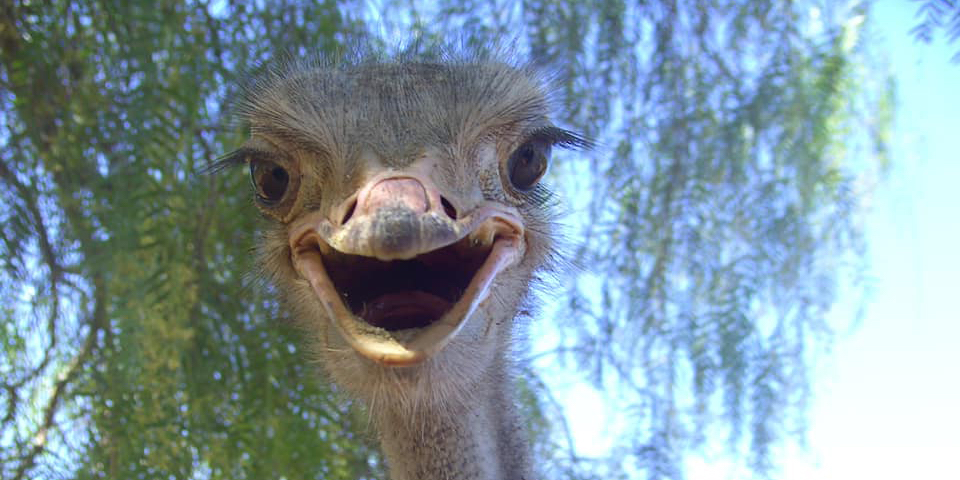
The South African ostrich has the largest eye of any land animal, measuring almost five cm (2 inches) across. This amazing adaptation enables these birds to see predators, such as lions, from far away. Other animals, especially zebra and other antelope, also use this adaptation and can often be found grazing near to an ostrich to take advantage of their early predator warning skills.
Interestingly enough, ostriches have eyes that are bigger than their brains. Although this means that they are not the smartest creature on the savanna, they are able to see long distances and have great location awareness.
The ostrich also has a long neck which also helps to spot predators. This neck of male and female ostriches have no feathers, only a thin layer of soft down. Ostriches cleverly use their necks to help them hide from predators. They press their necks into the ground to be less visible. This behaviour has lead to the myth that ostriches bury their heads in the sand, which is not actually the case.
South African Ostrich Leg and Toe Adaptations
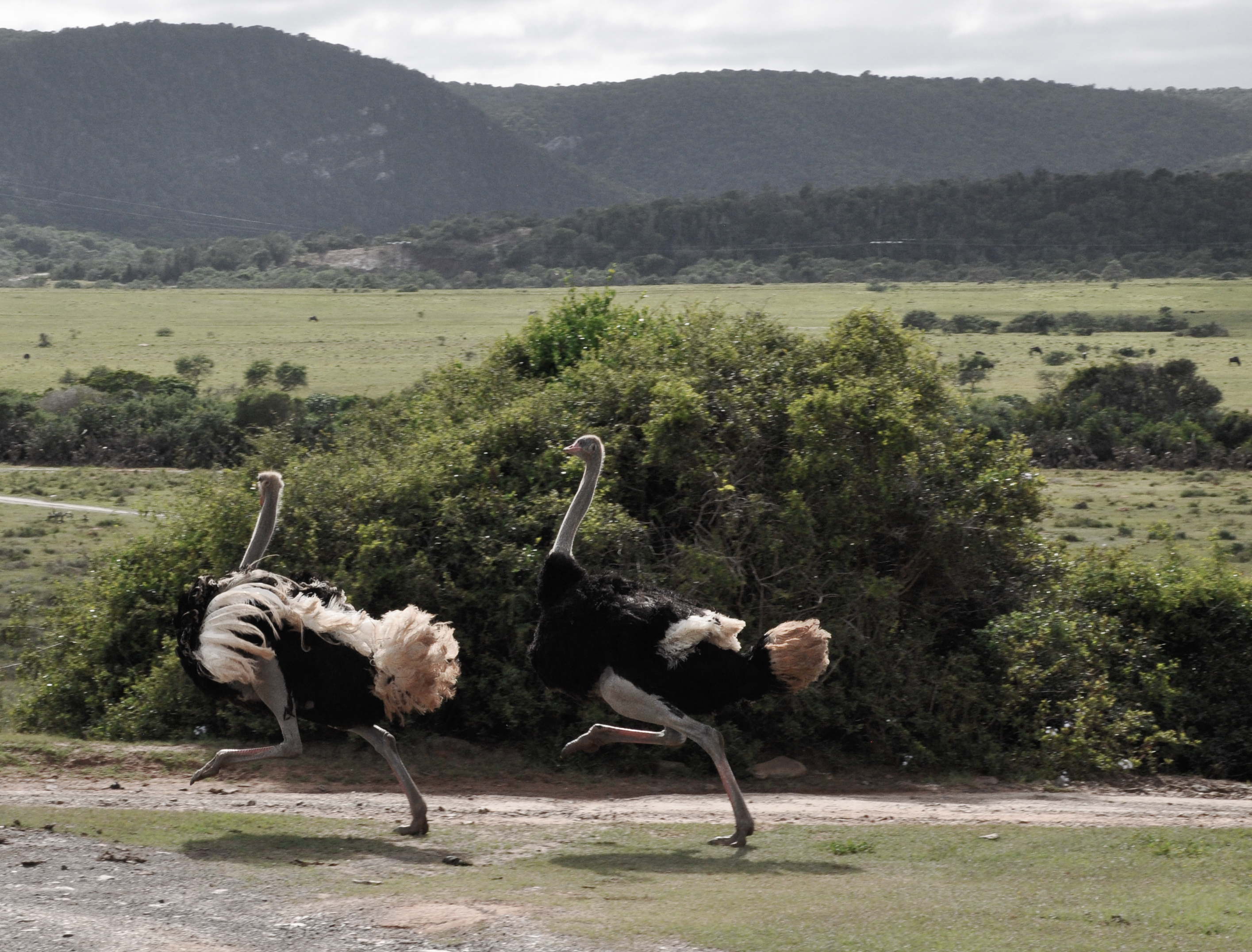
With its large body you would think that Mr. Big Bird wouldn't be able to move very fast. This is not the case as in nature you need to adapt or die. Ostriches have amazingly adapted legs and feet to help them run very fast and keep them one step ahead of predator's claws. Common ostriches can run up to 70 km/h (44 m/ph) using their long, strong and muscular legs.
If their speed is not enough protection, then ostriches have another trick up their feathery sleeves - their scaly and prehistoric feet. Ostriches are the only birds that have two toes per foot (instead of four) which helps them to run faster. Their largest toe is positioned on the inside of the foot and the smaller toe is on the outside. This adaptation helps to give the ostrich excellent balance when running. Their big toe also has a very large, sharp nail which provides additional protection against predators, intruders or opponents.
South African ostriches use their strong legs and sharp toenails as weapons. Their first line of defence is to run away, but if this option doesn't work they will turn to the danger and kick them. The forward kick of an ostrich can severely hurt a predator like a lion and is capable of killing a human. Ostriches also use their strong beaks to peck with immense strength. Not many animals stand a chance against an angry ostrich!
Amazing Adaptations: Ostrich Feeding & Digestion
Ostriches are omnivorous, meaning they eat vegetation and meat. They feed on a variety of food including grass, leaves, seeds, insects, lizards and other small creatures. There are even records of ostriches eating very strange objects like cloth, rope and an assortment of shiny objects including staples, hooks, nails and coins.
Ostriches don't have teeth to grind down food or a gall bladder to digest fats. They have adapted to these features by having three stomachs and swallowing pebbles and stones to help them with digestion. Ostriches pick up their food with their beaks, swallow it down their long throats and then it arrives in their proventriculus or glandular stomach. From here it goes into their muscular stomach, called the ventriculus. This is where small stones and other hard material is stored. These help the ostrich to grind their food. From here the food moves down to the small intestine where the nutrients and water are taken up before the undigested material is excreted from the body in a white fluid and solid waste.
Ostriches are the only bird species to pass urine separately from solid waste. All other birds pass urine and faeces together.
Ostriches can go several days without drinking water. They have adapted to using the moisture in their food. This allows ostriches to live in very dry areas. They do enjoy drinking water when available and can sometimes be seen taking a bath too.
Ostrich Breeding Adaptations
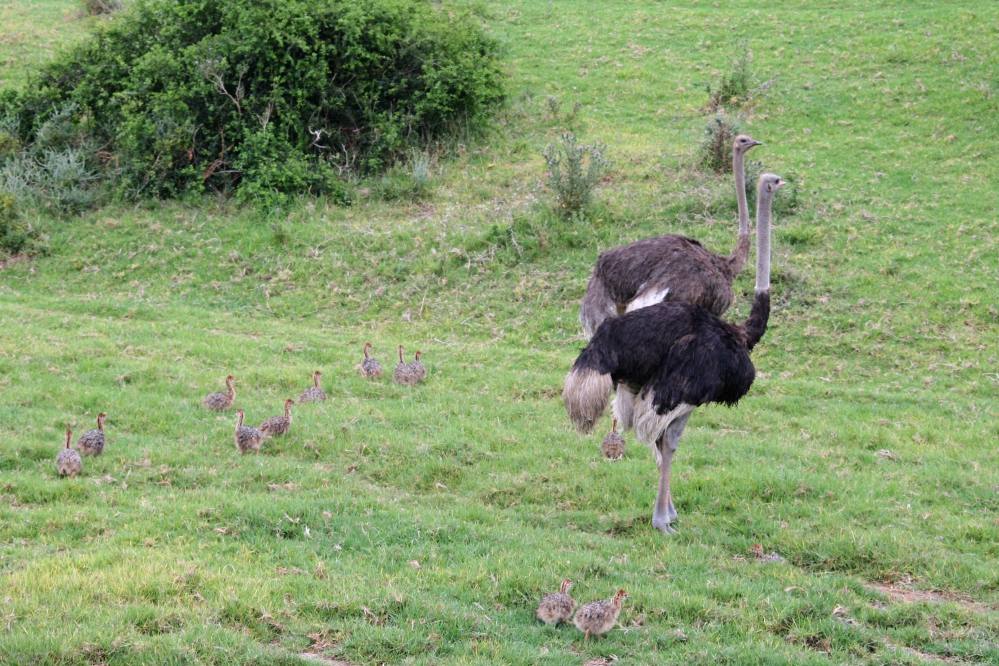
South African ostriches usually mate and breed at Kariega Game Reserve from June to late October. Males have various adaptations to signal that the breeding season has started. Firstly, the front of their legs and beaks start turning a pinkish-red colour to show that they are ready for action. This shows females that he is attractive and is also a sign to opponents that the time to fight for mating rights has arrived.
Secondly, males start to perform elaborate dancing displays for the females in order to impress them and get a chance to mate. In this dance the male sits down on the ground with his wings open and swings his neck from side to side while shaking his open wings to look even more impressive. This can go on for hours, and if the female isn't ready to mate or interested for some reason she won't accept him and he will have to go dance for another lady.
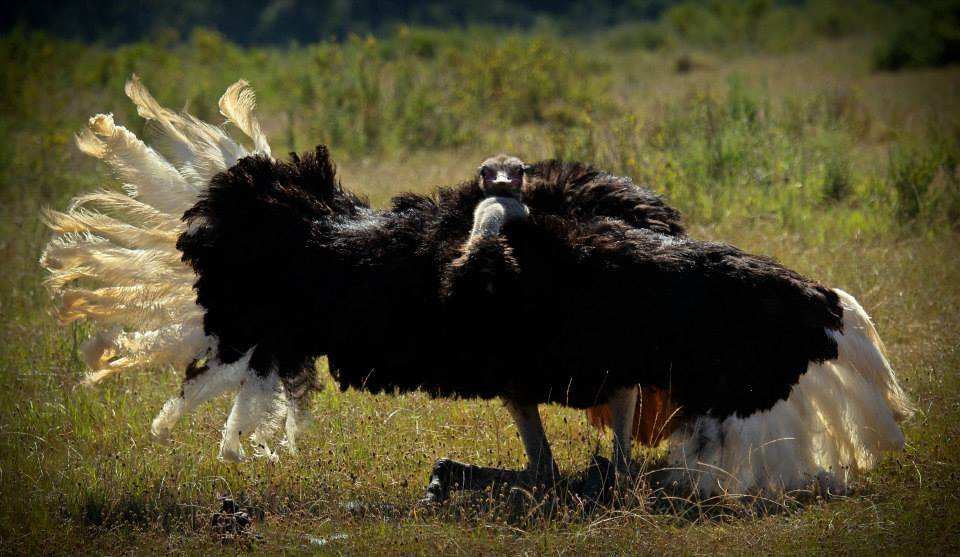
Female ostriches lay about 15 eggs per breeding season, and multiple females will sometimes lay their eggs in the same nest. There is always an adult on the nest to incubate and protect the eggs.
An amazing adaptation is that males usually sit on the eggs at night as their black plumage provides better camouflage. Females sit on the eggs during the day as their greyish coloured plumage offers better daytime camouflage.
Ostrich eggs are the largest egg on the planet and can weigh around 1.2 kilograms (2.6 lbs). The eggs take approximately 45 days to hatch. When the ostrich chicks pop out they are the size of a chicken. They can be the perfect snack for a hungry predator such as jackals, leopards, baboons and even large eagles.
Share Your Ostrich Sightings
Did you see South Africa ostriches on your safari at Kariega Game Reserve and find out about their amazing adaptations? If so, we would love to hear about your sightings and see your photos and videos. Share them with us by posting them on our social media channels: Facebook, Instagram, Twitter and YouTube. We also encourage you to subscribe to our blog so that you can receive updates via email.
We so look forward to welcoming safari guests again after our temporary closure. We look forward to showing you the amazing adaptations of South African animals and birds.
Video credit: Fergus Clark. Image credits: Kariega guests Graham Harvey, Teresa Dickenson and Kristina Leffler Säll. Male breeding display by Kariega APU leader Daniel Haesslich.

